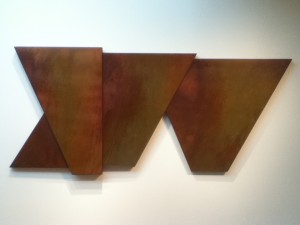During my travels, I love to take in the local art scene (no matter if it isn’t quite local….) Many people ask why art, if my work is in mathematics. Well, the truth is that before I was in mathematics, I was in visual arts: I was trained as a calligrapher, studied photography, printmaking, filmmaking, industrial arts and, to round it all out, mechanical drawing and architecture. With this kind of background, I developed all kinds of mathematical expertise, including an intuitive understanding of ratio and proportion from mixing chemicals in my darkroom and enlarging photos. I learned to measure precisely as well as how to work in scale through my years of mechanical drawing and architecture, and developed an eye for expressing mathematical relationships through my work in graphic design.
Here’s one of the examples of “art & math” I saw during my travels:
This is a piece by Bonnie Bronson entitled JAS #1. it’s a trio of metal plates attached to the wall. To me, it is a intricate juxtaposition of shape and space, which is what a lot of these artists are dong in their work.
Here are a few things I want to point out as you look at this:
- Where do you “begin” looking at this? Does it “read” from right to left, left to right, front to back or back to front? Should we look a the largest object first and then move to the smaller ones?
- Is there a predominant “shape?” How do the shapes “fit” together? They all seem to share a common height (the trapezoid in the front may be taller, or is that a trick of perspective?), and the back trapezoid seems to be the same as the one in the front, save it has been “complete” on the right side. Or is the smaller trapezoid a truncated version of the one in the back?
- The rhombus which separates the two shapes does so in many ways: besides separating them by space horizontally, it also creates a layer between them. Why is Kelly keeping the two related shapes away from one another?
- The smaller trapezoid has another function, besides being a part of the larger one; it also splits up the rhombus behind it, yet also completes it as rough approximation of the trapezoid that is on the end. What kinds of tricks is Kelly playing with us? And what about that trapezoid on the viewer’s right: it is partially obstructed by that rhombus. Is the rest of it there, or not? We assume these shapes are “filled,” but are they really?
So, what do you think? Is it just a couple of plates screwed into the wall, or is there really an “art” behind that “art?”

